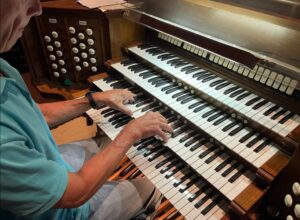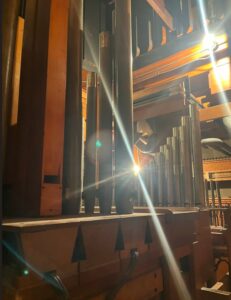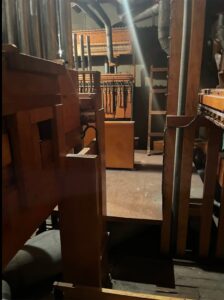 In the mid-1920s, a Roman Catholic church in Pasadena, CA, decided it wanted a top-of-the-line pipe organ for its sanctuary. It reached out to the Skinner Organ Company in Boston to construct this instrument. However, early in the building process, the church realized it was not going to have enough money to purchase the organ after all, so it backed out of its agreement.
In the mid-1920s, a Roman Catholic church in Pasadena, CA, decided it wanted a top-of-the-line pipe organ for its sanctuary. It reached out to the Skinner Organ Company in Boston to construct this instrument. However, early in the building process, the church realized it was not going to have enough money to purchase the organ after all, so it backed out of its agreement.
On the other side of the country, the First Presbyterian Church of Hazleton was also in the market for a high-end organ. The session found out about the organ that had been ordered and then canceled and decided to purchase that one. It seemed like a God-driven plan at the time. Little did either congregation know how this story would turn out.
Fast forward to 10 years ago when La Gran Cosecha, a local Latino congregation, approached the session at First Hazleton about the idea of using building space from the Presbyterian church to hold its weekly services. With the First Hazleton congregation shrinking in size, the building it owned now had plenty of space for another tenant. First Hazleton agreed to the idea, charging La Gran Cosecha only for some expenses so it could meet there.
“The community of Hazleton is rapidly changing,” explained Jane Dougherty, an elder at First Hazleton. “We were 99 percent white Americans, and now we are a 75 percent Latino population in the area. It’s a big change.
“Our congregation is smaller, older,” Jane continued. “The expenses of the big building, which was built in 1869, were great. It’s harder to heat a building that size in the winter in Hazleton. We’re on top of the mountain, and it gets cold and blustery here in the winter, and we would get a heat bill for $6,000 for a month in January.”
As the First Hazleton congregation continued to downsize, making it harder and harder financially to stay afloat, last year it met with the Latino congregation it was sharing space with to see if it would be interested in purchasing the building. They quickly accepted the offer.
“We have some money but it’s rapidly going because we’re not taking in enough to maintain those expenses,” Jane said. “The Latino congregation several times over the years said if you ever decide to sell, we want to be first in line.
“They are a large congregation. Young families, older families, multi-generational families. They are very active, and they were in the building three or four days a week. We had a very nice partnership with them. Everyone was happy with the agreement.”
 A caveat was that the Presbyterian congregation would be allowed to continue to worship in the chapel and have office space – rent free. Another condition was that the organ in the sanctuary where the Latino congregation worships weekly was still the property of First Hazleton. This means the Presbyterian congregation would be allowed to sell the organ and keep the funds to benefit its mission program, which includes providing meals for a local homeless shelter and coordinating local English as a Second Language classes.
A caveat was that the Presbyterian congregation would be allowed to continue to worship in the chapel and have office space – rent free. Another condition was that the organ in the sanctuary where the Latino congregation worships weekly was still the property of First Hazleton. This means the Presbyterian congregation would be allowed to sell the organ and keep the funds to benefit its mission program, which includes providing meals for a local homeless shelter and coordinating local English as a Second Language classes.
“Our Latino friends use keyboards, drums and guitars,” Jane said. “They don’t use the piano, they don’t use the Skinner organ. They don’t have anyone who’s capable of playing an instrument like that. And it’s not their type of music either.”
La Gran Cosecha agreed to these terms. After the paperwork was signed, First Hazleton posted on an organ clearinghouse website that it was selling its 1927 Skinner pipe organ. Within 24 hours, five interested people responded.
“It’s very much in demand and very much coveted by organists,” Jane said of the organ.
Among the curious potential buyers was the organist from St. Andrew Catholic Church in Pasadena, CA. He made the two-day cross-country trip by car to see the organ, leaving just hours after contacting First Hazleton about the instrument.
The traveler liked what he saw, and an agreement between the two congregations was quickly agreed upon. The $25,000 organ that First Hazleton purchased nearly a century ago was headed back to Pasadena at an agreed-upon price of $75,000. It is costing St. Andrew much more than that though, as it paid for the disassembling, repairs, shipping costs across the country and reassembling. The entire process is expected to take 18 months and will cost St. Andrew an estimated $2 million.
“I don’t think they were really in the market for an organ,” Jane said. “I think it just was happenstance that he was interested in Skinner organs, paid attention to this organ clearinghouse and saw the organ for sale.”
The kicker is neither First Hazleton nor St. Andrew knew of this organ’s history when it was sold to the Pasadena congregation. It wasn’t until after the sale that it was discovered through records held at the Skinner Organ Company that St. Andrew had originally commissioned to have this pipe organ built, soon after determined it could not afford the instrument, and Skinner transferred the project to First Hazleton.
“They were flabbergasted by that,” Jane said when recalling the conversation with St. Andrew about the history of the organ. “It was just a moment of serendipity where we all said, ‘Wow.’ It is almost unbelievable.
The sale of the organ combined with the building being sold to a congregation that has allowed First Hazleton to stay there has provided everyone with a strong sense of fulfillment.
“Of course we had some mixed feelings about selling our building, especially those of us who have been around a while – people who were baptized there like my brother and me. We said this is kind of a sad moment that we’re selling our building. Then we said this is a wonderful thing. This organ is not only going to a good home, it’s going where it was supposed to go to begin with. It really made all of us feel very good.”
“It was definitely God-driven because everything just fell into place. Everything just worked magically almost, and you know it was God’s hand at work saying, ‘This congregation isn’t finished yet. They have lots to do, and this is going to help them do that.’”
A dedication of the organ at St. Andrew Church in Pasadena is earmarked for the summer of 2026, and members of First Hazleton have been invited to attend that service. It will bring full circle one more God moment in the history of this pipe organ.
“It was bittersweet,” Jane said when she looked at the organ spread out in thousands of pieces throughout the sanctuary as it was being disassembled. “Knowing that it was going to a wonderful home and knowing that we got $75,000 from it made it much easier to take.
“We’re all saying that this is just almost more than you can believe.”

